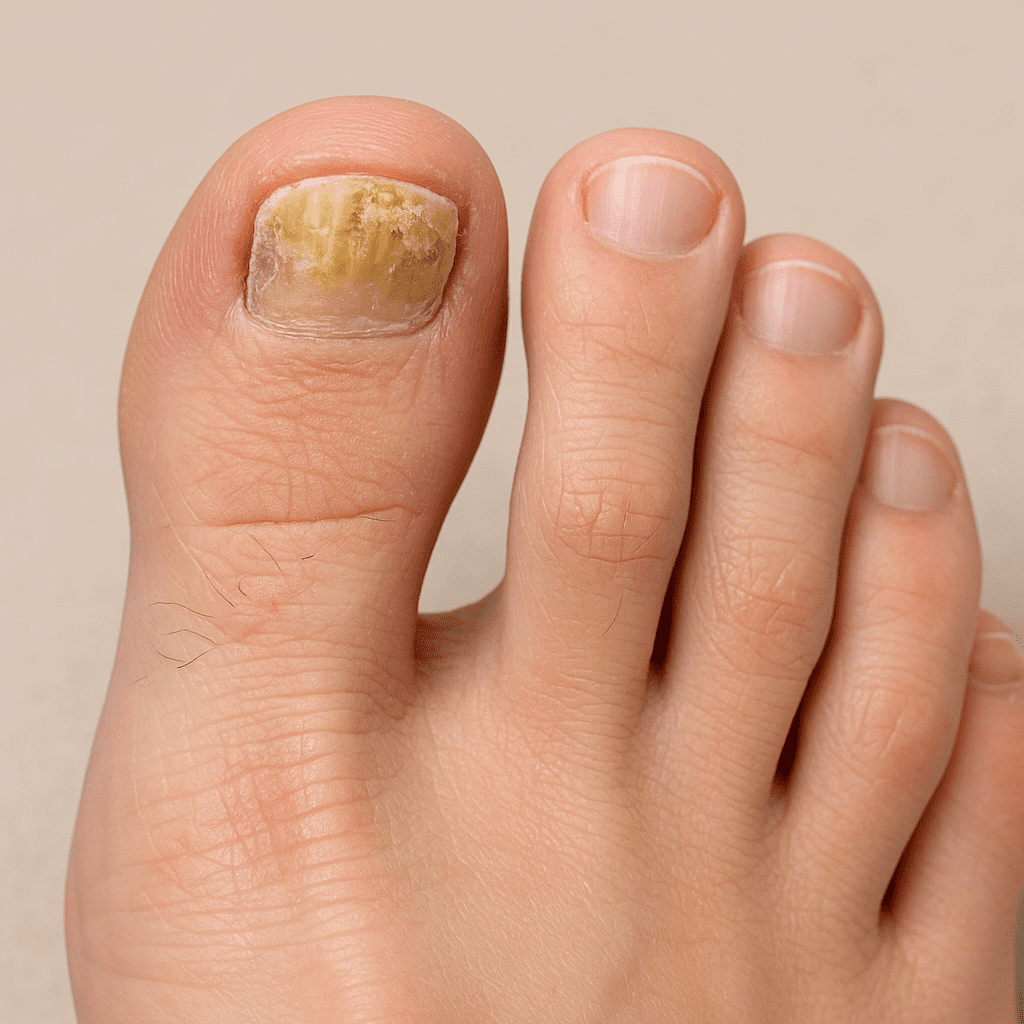What is Nail Fungus?
Nail fungus, medically known as onychomycosis, is a common condition where fungi infect the fingernails or toenails. It typically begins as a white or yellow spot under the tip of your nail. As the fungal infection goes deeper, it can cause the nail to discolor, thicken, and crumble at the edge.
This condition isn’t just a cosmetic issue—it can lead to pain, permanent nail damage, and the potential for serious infections that may spread beyond the feet if not properly treated.
Many people confuse nail fungus with other nail disorders such as psoriasis or trauma-induced changes. That’s why accurate diagnosis is crucial.

Causes of Nail Fungus
Fungi thrive in warm, moist environments. The primary culprits include dermatophytes, yeasts, and molds. These organisms invade your nails through tiny cracks in the skin or nail, especially when your immune system is weakened or your feet are constantly in damp conditions.
Key Contributing Factors:
Walking barefoot in public areas (like swimming pools or gym showers)
Wearing sweaty or tight-fitting shoes for prolonged periods
Having athlete’s foot or other skin fungal infections
Nail injuries or skin conditions around the nails
Diabetes, poor circulation, or weakened immune systems
Common Symptoms of Nail Fungus
Symptoms develop slowly and may not be immediately noticeable. Here’s what to watch for:
Discoloration: Yellow, brown, or white nails
Thickening: Nails become unusually thick
Brittle Texture: Crumbly or ragged edges
Distorted Shape: Nails lose their normal contour
Odor: Foul smell from infected nails
Separation: Nail lifting off from the nail bed
If any of these symptoms persist or worsen, it’s essential to consult a healthcare provider.
Types of Nail Fungus
Distal Subungual Onychomycosis:
The most common form, affecting the nail bed and underside of the nail.White Superficial Onychomycosis:
Appears as white spots on the nail surface, usually easy to treat.Proximal Subungual Onychomycosis:
Often affects people with weakened immunity, begins at the cuticle.Candida Onychomycosis:
Caused by yeast, often seen in fingernails and associated with frequent water exposure.
How Nail Fungus Spreads
Fungal infections are highly contagious. Here’s how it travels:
Direct Contact: Sharing nail clippers, socks, or shoes.
Contaminated Surfaces: Floors in gyms, locker rooms, and public showers.
Improper Salon Hygiene: Using unsterilized manicure or pedicure tools.
Always practice good hygiene and avoid barefoot contact in public places to minimize the risk.
Risk Factors for Developing Nail Fungus
Certain conditions increase susceptibility, such as:
Aging (reduced blood flow, slower nail growth)
Sweaty feet or tight footwear
History of athlete’s foot
Diabetes or circulatory problems
Weakened immune systems
Understanding your risk can help in early prevention and management.
Diagnosing Nail Fungus
Doctors typically examine the nail and may collect debris from under the nail for testing. Lab tests (microscopy or culture) confirm the diagnosis and rule out other conditions like psoriasis or lichen planus.
Over-the-Counter Treatments
Mild fungal infections may respond to OTC solutions. Popular options include:
Topical Antifungal Creams: Clotrimazole or terbinafine
Medicated Nail Lacquers: Ciclopirox (Penlac)
These treatments work best in early stages and require consistent daily use for several months.
Prescription Treatments
For more stubborn or severe infections:
Oral Antifungal Drugs: Terbinafine (Lamisil) or itraconazole (Sporanox) are commonly prescribed.
Laser Therapy: A non-invasive, high-tech option that targets fungus without harming the nail.
Always follow your doctor’s advice, as oral medications can have side effects and require monitoring.
Home Remedies for Nail Fungus
Some people find relief with natural treatments, though results can vary.
Popular Remedies:
Tea Tree Oil: Antifungal and antiseptic properties
Vinegar Soaks: Apple cider vinegar in warm water
Garlic Paste: Contains allicin, a natural antifungal agent
Baking Soda: Helps neutralize foot odor and fungi
While these aren’t quick fixes, they can support conventional treatments.
Lifestyle Changes for Effective Healing
Keep nails short, dry, and clean
Avoid tight shoes and change socks daily
Disinfect clippers and tools regularly
Let feet breathe—go barefoot at home
Use antifungal powder in shoes
These small steps can accelerate healing and prevent recurrence.
How to Prevent Nail Fungus
Prevention is always better than cure.
Tips to Stay Fungus-Free:
Wear shower shoes in public places
Use antifungal sprays or powders in shoes
Dry your feet thoroughly, especially between toes
Choose moisture-wicking socks and breathable shoes
Avoid sharing personal grooming tools
Nail Fungus in Children vs. Adults
Children rarely get nail fungus, but when they do, it’s often due to injuries or weakened immunity. Adults, especially seniors, are at higher risk due to slower nail growth and circulation issues.
Treatment for children is typically milder and supervised by pediatricians.
Myths and Misconceptions About Nail Fungus
Myth: Only dirty people get nail fungus
Fact: Even the cleanest individuals can catch it in public areas.
Myth: It’s just cosmetic
Fact: It can cause pain, infection, and permanent damage.
Myth: You can’t cure it
Fact: With proper treatment and patience, nail fungus is beatable.
Complications if Left Untreated
Ignoring nail fungus can lead to:
Spread to other nails or body parts
Permanent nail deformity
Secondary bacterial infections
Pain and difficulty walking
When to See a Specialist
If you notice:
Persistent pain or swelling
Rapid nail discoloration
Recurring infections despite treatment
It’s time to visit a dermatologist or podiatrist for expert care.
FAQs About Nail Fungus
1. How long does it take to cure nail fungus?
It can take 6-12 months for nails to fully grow out and clear, depending on severity and treatment.
2. Can nail fungus return after treatment?
Yes, without preventive care, reinfection is common.
3. Is nail fungus contagious?
Absolutely. It can spread through shared items or contact with infected surfaces.
4. Do I need to remove my nail to treat fungus?
In rare severe cases, yes. Usually, treatments work without nail removal.
5. Are home remedies effective for nail fungus?
They may help in mild cases but are less reliable than medical treatments.
6. Is laser treatment safe for nail fungus?
Yes, it’s FDA-approved, but typically more expensive than other treatments.
Final Thoughts on Nail Fungus
Nail fungus may seem like a small problem, but it can grow into a major one without proper attention. Thankfully, it’s treatable with the right approach—whether that’s through medication, lifestyle changes, or early prevention. Take action early, stay consistent, and you’ll regain healthy, clear nails in no time.
How to Get Rid of Nail Fungus
If you’re tired of recurring nail fungus and over-the-counter treatments that just don’t work, it might be time to try a definitive, all-natural solution—AppaNail.
Why Choose AppaNail?
AppaNail is a powerful antifungal supplement formulated with scientifically backed ingredients that target fungus from the inside out. Unlike topical treatments that only scratch the surface, AppaNail works systemically to:
- Strengthen your immune response to fungal infections
- Promote healthy nail regrowth
- Eliminate the root cause of onychomycosis
- Prevent future outbreaks
Thousands of users have reported visible improvement in weeks, with full recovery following consistent use. It’s safe, easy to use, and doesn’t involve messy creams or risky medications.
If you’re ready to reclaim clear, healthy nails—AppaNail is your go-to solution.
👉 Click the button below to get AppaNail now at a special discounted price!
Special Offer Today: 80% OFF + Free Shipping!
